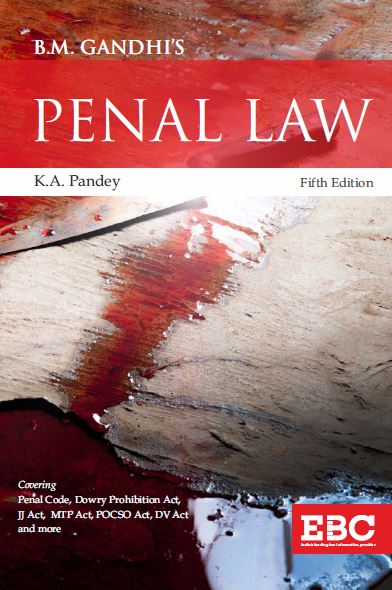This new edition of B.M. Gandhi’s Penal Law revised by Dr K.A. Pandey is an authoritative commentary on the subject. The author has thoroughly revised and updated this work incorporating the latest statutory and case law.
The following are the notable features of this new edition:
1. The title has been changed to Penal Law to reflect the new way to study this subject. The Penal Code can no longer be studied in isolation. All supplementary criminal laws must be studied in conjunction.
2. Analyses the provisions of the Criminal Law (Amendment) Act, 2018, Air (Prevention and Control of Pollution) Act, 1981, Bonded Labour System (Abolition) Act, 1976, Child and Adolescent Labour (Prohibition and Regulation) Act, 1986, Coinage Act, 2011, Commission of Sati (Prevention) Act, 1987, Contempt of Courts Act, 1971, Dowry Prohibition Act, 1961, Drugs and Cosmetics Act, 1940, Environment (Protection) Act, 1986, Food Safety and Standards Act, 2006, Immoral Traffic (Prevention) Act, 1956, Information Technology Act, 2000, Juvenile Justice (Care and Protection of Children) Act, 2015, Legal Metrology Act, 2009, Maharashtra Control of Organised Crime Act, 1999, Medical Termination of Pregnancy Act, 1971, Motor Vehicles Act, 1988, Pre-Conception and Pre-Natal Diagnostic Techniques (Prohibition of Sex Selection) Act, 1994, Prevention of Corruption Act, 1988, Protection of Children from Sexual Offences Act, 2012, Protection of Women from Domestic Violence Act, 2005, Representation of the People Act, 1951, Sexual Harassment of Women at Workplace (Prevention, Prohibition and Redressal) Act, 2013, Water (Prevention and Control of Pollution) Act, 1974.
3. Aggravated forms of offenses and their cognate offenses have been grouped for easy grasping.
4. Contains recommendations from the Law Commission of India and important committees.
5. Contains relevant provisions of connected legislation to impart complete knowledge. For example, the criminal liability of a child has been discussed vis-a-vis the Juvenile Justice (Care and Protection of Children) Act, of 2015.
6. Incorporates the latest thinking on the various aspects of criminal law.
7. Overview at the start of each chapter prepares the reader to easily learn and conceptualize things discussed in the chapter.
8. Three appendices are devoted to the rights of the undertrial and convicts, penology, and victimology.
The book will be immensely useful for students of LL.B., and LL.M., and for candidates preparing for Judicial and Civil Service Exams. The book is a must for law enforcement agencies, police officers, law teachers, researchers, scholars, and practicing lawyers.
Reviews
Distinct from other books on the Code is that it briefly discusses the concept of socio-economic crimes with a historical outline of their origin and their nature and scope; it also mentions the nexus between politics and crime and provides a statistical estimate of crimes likely to be committed in India of the 21st century.
– Cochin University Law Review
The book can be claimed to be a rational combination of a textbook and a lawyer’s commentary and this feature has been rightly claimed as its novel feature. The book has merits of its own and deserves a place in all law libraries.
– Central India Law Quarterly
A novel feature of the book is that while presenting a topic, its meaning, the principle involved, the object and scope, an explanation of terms and exceptions, and comments thereon are given. The distinctions between terms and various sections are explained.





Reviews
There are no reviews yet.